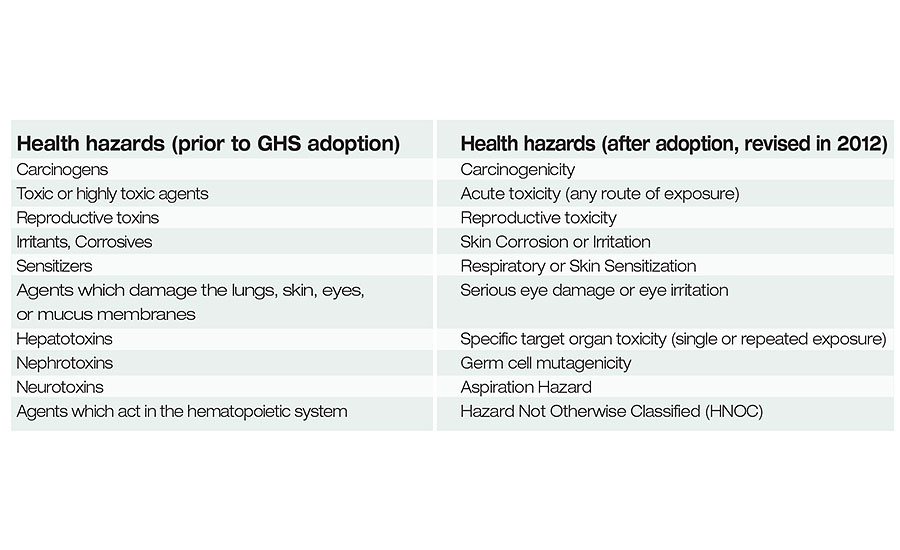The EPA established a final rule on June 13, 2016 (effective compliance date January 1, 2018) to revise reporting requirements under section 311 and 312 of the Emergency Planning and Community Right-to-Know Act.1 The revision aligns EPA rules with OSHA’s 2012 Hazard Communication Standard (GHS). Table I show EPA’s revised health hazard categories prior and post GHS.
In-depth Hazwoper training, using spill scenarios and site-specific safety data sheets (SDS), connects germ cell mutagenicity with the hazard statement: “May cause genetic defects.” It appears this new health hazard classification bothers employees.
When I first stumbled on this issue as an instructor during recent multiple Hazwoper training courses for several clients, I was taken aback at a student’s level of concern. Most safety and health pros don’t consider mutagenicity a new health hazard. But most employees are not pros. We need to know what’s in the employee’s mind to help address concerns. Concern is the second step in the escalating 4C risk communication process that consists of curiosity, concern, controversy and conflict.
Growing interest in genetics
Curiosity on genetics has been stoked in recent years by the rise in number of DNA testing companies and the hype they offer. Companies such as AncestryDNA and 23andMe each has already served more than one million customers. Dozens of DNA testing companies exist, however.2 It is not unusual to find that some employees and their family have taken one or more of these DNA tests.
The genetics market is ripe for growth with price for some home DNA tests below $100 and the hype that tests may go beyond genealogy to promote the prevention of future disease.
Mystery and allure
The mystery and allure of genetics is the heart of some of the highest-grossing entertainment films in the last few years. Spiderman, Hulk, X-men, and the Fantastic Four are just a few of the many examples. Rapid DNA tests, backed by science and court approvals, are now conducted in less than two hours with portable instruments. Police and security forces worldwide are clamoring for rapid DNA use. In July 2016, a Minnesota state judge ruled that potential heirs to the late singer Prince’s $250 million estate must undergo genetic testing to prove a blood relationship.
OSHA HazCom requires that employees must be trained on newly identified health hazards. OSHA’s GHS germ cell mutagenicity classification means that some common chemicals, such as ethanol, now must include a hazard statement on SDS and labels that the chemical may cause or is suspected of causing genetic defects. Germ cell mutagenicity chemicals might have been previously used in the workplace with limited concern; post GHS the chemical now becomes a newly identified health hazard requiring employee training.
Right to understand
Employees might not be satisfied with a simple explanation that a genetic defect is caused in whole or in part by a change in the normal DNA sequence.
To help you prepare for new training, here are some questions employees have recently asked me about germ cell mutagenicity hazards.
1. What’s a “germ cell?” Why do they call it a “germ?”
2. Why did OSHA create the new classification for germ cell mutagenicity?
3. Are genetic defects on the rise?
4. Does mutagenicity cause (OSHA classification) cancer?
5. Is mutagenicity (OSHA classification) toxic to reproduction?
6. Can I have a genetic defect now and not know it?
7. My wife has a genetic defect; could she have got it from me?
8. Can a genetic defect be cured?
9. How do genetic defects get passed onto the spouse, children or future grandchildren?
10. What are the odds that my children may inherit my genetic defect?
11. Do PELs and TLVs protect against genetic defects?
12. Are there other workplace exposure limits to protect from genetic defects?
13. What are some examples of genetic defects caused by chemical exposure?
14. Other than chemical exposure, can other workplace hazards cause genetic defects?
15. Do multiple exposures to mutagenicity hazards multiply risks for genetic defects?
16. Should I get a DNA test for a workplace medical baseline?
17. Who pays for a DNA test if I’m overexposed to a chemical that may cause a genetic defect?
18. Should I keep my DNA confidential?
19. The SDS says “obtain special instructions before use.” What are the special instructions?
20. May I voluntarily wear PPE to lower risks of contracting a genetic defect from work?
Allowing your workforce to develop their own answers through the rumor-mill is a poor decision and out of step with OSHA requirements. Training on germ cell mutagenicity and genetic defects must transition from hazard communication to risk communication.
References:


